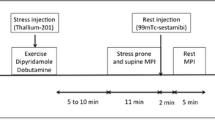Abstract
The myocardial uptake and redistribution in thallium scintigraphy and the regional wall motion by echocardiography were evaluated by a semi-quantitative method in 42 patients who previously had myocardial infarction (50 target vessels) and underwent coronary revascularization. The aim of this study was to elucidate the significance of the initial image, delayed image and redistribution on thallium-201 scintigraphy for clinical diagnosis of the myocardial viability. As a semi-quantitative analysis, we used a bull’s-eye display for thallium image and centerline method for echocardiographic wall motion, and compared the results before and after revascularization. As a result, the thallium grade improved postoperatively in all 17 areas which preoperative had showed redistribution, and also in 11 of the 32 areas without preoperative redistribution. The sensitivity, specificity and accuracy of preoperative thallium redistribution for predicting myocardial viability were 61%, 100% and 78%, respectively, when the postoperative improvement in the thallium grade was used as the standard. The postoperative probability of improvement in the thallium grade increased in proportion to the preoperative thallium grade (delayed image) (p≪0.01). There was no correlation between the preoperative thallium delayed image and postoperative improvement in wall motion. Postoperative improvement in thallium image and wall motion could not be predicted from the preoperative wall motion. Thus, postoperative improvement in thallium images can be anticipated if redistribution is present on the preoperative thallium image, and the preoperative thallium delayed image is useful for predicting myocardial viability. Improvement in wall motion could not be predicted preoperatively by these methods.
Similar content being viewed by others
References
Strauss HW: Thallium redistribution: Mechanisms and clinical utility.Seminar Nucl Med 10: 70–93, 1980
Rozanski A, Berman DS, Gray R, et al: Use of thallium-201 redistribution scintigraphy in the preoperative differentiation of reversible and non-reversible myocardial asynergy.Circulation 64: 936–944, 1981
Pohost GM, Zir LM, Moore RH, et al: Differentiation of transiently ischemic from infarcted myocardium by serial imaging after a single dose of thallium-201.Circulation 55: 294–301, 1977
Liu P, Kiess MC, Okada RD, et al: The persistent defect on exercise thallium imaging and its fate after revascularization: does it represent scar or ischemia?Am Heart J 110: 996–1001, 1985
Naruse H, Ohyanagi M, Iwasaki T, et al: Indications for coronary revascularization and the postoperative evaluations using thallium-201 exercise myocardial scintigraphy and a bull’s eye display.Am J Noninvas Cardiol 4: 352–357, 1990
Gibson RS, Watson DD, Taylor GJ, et al: Prospective assessment of regional myocardial perfusion before and after coronary revascularization surgery by quantitative thallium-201 scintigraphy.J Am Cardiol 1: 804–815, 1983
Depasque EE, Nody AC DePuey et al: Quantitative rotational thallium-201 tomography for identifying and localizing coronary artery disase.Circulation 77: 316–327, 1988
Sheehan FH, Bolson EL, Dodge HT, et al: Advantages and applications of the centerline method for characterizing regional ventricular function.Circulation 74: 293–305, 1986
Rigo P, Bailey IK, Griffith LSC, et al: Value and limitation of segmental myocardial imaging for localization of coronary artery disease.Circulation 61: 973–981, 1980
Ritchie JL, Trobaugh GB, Hamilton GW, et al: Myocardial imaging with thallium-201 at rest and during exercise. Comparison with coronary arteriography and resting and stress electrocardiography.Circulation 56: 66–71, 1977
Kolibash AJ, Call TD, Bush CA, et al: Myocardial perfusion as an indication of graft patency after coronary bypass surgery.Circulation 61: 882–887, 1980
Shabaro JA, Karunatne H, Cantez S, et al: Thallium-201 imaging in assessment of aortocoronary bypass graft patenty.Br Heart J 42: 552–561, 1979
Scholl JM, Chaitman BR, David PR, et al: Exercise electrocardiography and myocardial scintigraphy in the serial evaluation of the results of percutaneous transluminal coronary angioplasty.Circulation 66: 380–399, 1982
Hirzel HO, Nuesch K, Gruenzig AR, et al: Short and long term changes in myocardial perfusion after percutaneous transluminal coronary angioplasty assessed by thallium-201 exercise scintigraphy.Circulation 63: 1001–1007, 1981
Wainwright RJ, Brennaud-Roger DA, Maisey MN, et al: Exercise thallium-201 myocardial scintigraphy in the follow up of aortocoronary bypass graft surgery.Br Heart J 43: 56–66, 1980
Goodwin PN: Recent developments in instrumentation for emission computed tomography.Semin Nucl Med 10: 322–334, 1980
Burow RD, Pond M, Schafer AW, et al: “Circumferential profiles: “A new method for computer analysis of thallium-201 myocardial perfusion images.J Nucl Med 20: 771–777, 1979
Manyari DE, Knudtson M, Kloiber R, et al: Sequential thallium-201 myocardial perfusion studies after successful percutaneous transluminal coronary angioplasty: delayed resolution of exercise-induced scintigraphic abnormalities.Circulation 77: 86–95, 1988
Bodenheimer MM, Banka VS, Hermann GA, et al: Reversible asynergy. Histopathologic and electro-cardiographic correlations in patients with coronary artery disease.Circulation 53: 792–796, 1976
Gutman J, Berman DS, Freeman M, et al: Time to complete redistribution of thallium-201 in exercise myocardial scintigraphy: Relationship to the degree of coronary artery stenosis.Am Heart J 106: 989–995, 1983
Tamaki N, Yonekura Y, Senda M, et al: Value and limitation of stress thallium-201 single photon emission computed tomography: Comparison with nitrogen-13 ammonia positron tomography.J Nucl Med 29: 1181–1188, 1988
Author information
Authors and Affiliations
Rights and permissions
About this article
Cite this article
Naruse, H., Ohyanagi, M., Iwasaki, T. et al. Preoperative evaluation of myocardial viability by thallium-201 imaging in patients with old myocardial infarction who underwent coronary revascularization. Ann Nucl Med 6, 51–58 (1992). https://doi.org/10.1007/BF03164642
Received:
Accepted:
Issue Date:
DOI: https://doi.org/10.1007/BF03164642




